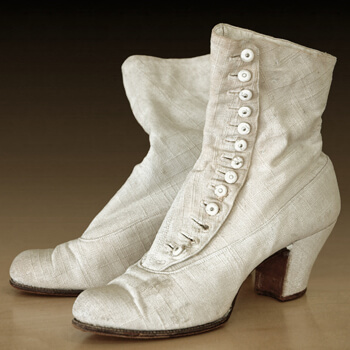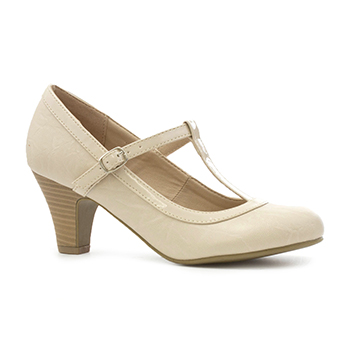A History of Women's Shoes: Timeline
The First Shoes (1550 BC) – The first shoes were basic, wrap-around leather creations that actually quite closely resembled today’s moccasins.
Roman Shoes (0050 BC) – Indoors, Roman women generally wore sandals, a style of shoe that is still popular today in the summer months. They also wore outdoor boots called “Calcei” that covered the toes and ankles, and had leather straps. There were not really any differences between men’s and women’s footwear. Romans did, however, use their footwear to indicate the power and social status of the wearer, as we’ve mentioned above.
Renaissance Women's Shoes – In the middle ages (between the 5th and 15th centuries), footwear continued to be more practical than fashionable and was generally made from leather. It wasn't until the Renaissance era that shoes began to more closely resemble the functional and fashionable items we wear today.
Rounded toes were first seen around the 15th century and high heels (then known as “Chopines”) began to emerge in the 16th and 17th centuries for what began as practical purposes. Casual women's shoes around this era were generally soft slippers, made from delicate fabrics like silk.

18th and 19th Century Women's Shoes – During the 18th century, the Napoleonic Wars were happening, meaning many shoes were made for military purposes. Once the wars had passed, however, the 19th century (and the industrial revolution with it) had begun to dawn, bringing with it new manufacturing processes that allowed shoemakers to create shoes that were practical and attractive.
These practices also led to the differentiation between men’s and women’s shoes, with small, delicate pumps and more elaborate high heels favoured by women and men favouring more functional leather boots.
Early 20th Century Women's Shoes – During the Edwardian era, other shoe styles appeared, with lower 'Oxford' heels, fabric pumps and 'flats' the dominating women’s shoe trends. There were also high, lace-up women’s boots, colloquially now known as 'Edwardian Boots', which were often heavily embroidered.
1920/30s – The 20s and 30s brought with them a combination of glamour and budget-consciousness. As the world blossomed into an altogether more liberal place, women's shoes adapted and became more flamboyant. 'Cuban' heels and rounded toes became the standard for formal shoes, in order to make the feet appear more petite. The most popular design of the 20s was the T-strap, which included a strap over the front of the shoe that was often decorated with beads and other embellishments.
In the 30s, meanwhile, the 'Oxford' design, with its subtle laces or bows and higher 'Spanish' heels became popular, with improvements in leather tanning meaning more colour options and two-tone combinations were also available.
1940/50s – During World War II, shoes were very restrained, however once the war ended they became much less so. General styles remained largely similar to the shoes worn in previous decades, but the designs became more elaborate. The slingback also made its debut in this period, with the exposed heel leading to it being considered a very 'sexy' shoe. It was, however, notoriously uncomfortable! Slip-in heel pumps were also popular, offering a more casual alternative to the Oxfords and slingbacks.
The 1950s also saw the birth and rise of the stiletto heel, with designers falling over themselves to design the skinniest one!

1960s/70s – Comfort continued to take a backseat to glamour throughout the 60s and 70s, at least when it came to formal wear. Day-to-day the 60s was, however, very much the era of the teenager, so alongside the higher heels favoured by their mothers, young girls were experimenting with function over fashion. Pumps and trainers became popular amongst young women for daily wear, with pointed flat shoes with low heels favoured for evening and social wear.
The 60s also saw the Mary Jane shoe take off, with its Cuban heel and neat, single strap design finding a perfect middle-ground between comfort and style. These were the perfect dancing shoes for the time, which was probably why they became so popular. The swinging 60s and 70s were all about the music after all! On that note, the 70s also saw the rise of disco culture and the return of super-high heels, though the heels were generally fairly chunky to allow for greater comfort and more decoration.
1980s/90s – This era was all about the trainers, though there were other styles that coloured the decades that 'taste forgot'. Jelly shoes, first seen in the 1970s and made from cheap PVC plastic, were popular with young girls. Platform shoes continued to find their place in certain circles. And we mustn’t forget the return of stilettos as power-dressing came in, but this was the era of the boot above all others.
The frankly ridiculous Moon Boots were the surprise hit of the 80s and Dr. Martens, often heavily decorated, were worn by all 'alternative' generation X kids in the 90s. The 90s was the era when women discovered that being comfortable and being 'on-trend' didn't need to be mutually exclusive.
21st Century Women's Shoes – At the dawn of the new century, fashions changed surprisingly little when it came to footwear. Ugg-style boots were the big story of the early 00s, and big-name designer brands gained more prominence, but in general, the 'noughties' acted as more of an evolution than a revolution. Indeed, even the notorious 'Crocs' were an evolution of the jelly shoe!